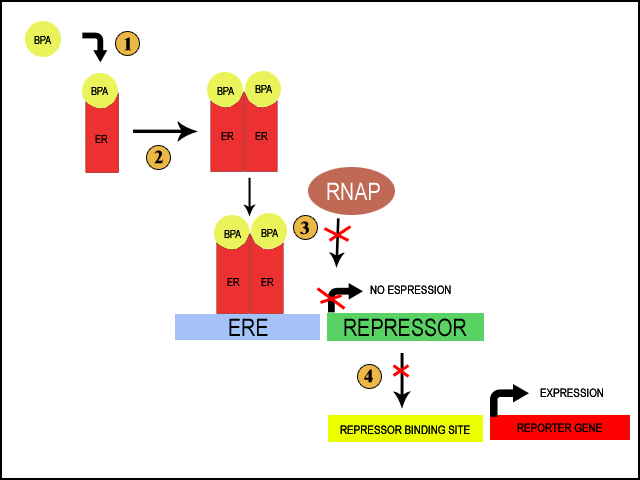Team:University of Alberta/Plastic Project:The University of Alberta
From 2008.igem.org
(→Info) |
(→Bisphenol A) |
||
| Line 105: | Line 105: | ||
<li>'''Bisphenol A Degradation by Bacteria Isolated from River Water''': J.-H. Kang and F. Kondo. | <li>'''Bisphenol A Degradation by Bacteria Isolated from River Water''': J.-H. Kang and F. Kondo. | ||
<br>[http://www.springerlink.com/content/ge1mec9289r4cw3w/fulltext.pdf Link] <br> | <br>[http://www.springerlink.com/content/ge1mec9289r4cw3w/fulltext.pdf Link] <br> | ||
| + | |||
| + | ===Prokaryotic Expression=== | ||
| + | |||
| + | <li>'''High level expression of full-length estrogen receptor in | ||
| + | Escherichia coli is facilitated by the uncoupler of oxidative | ||
| + | phosphorylation, CCCP''':Cheng Cheng Zhang, Kevin A. Glenn 1, Martin A. Kuntz, David J. Shapiro. Journal of Steroid Biochemistry & Molecular Biology 74 (2000) 169–178 <br> | ||
| + | [http://www.sciencedirect.com/science?_ob=ArticleURL&_udi=B6T8X-4233BF2-2&_user=1067472&_rdoc=1&_fmt=&_orig=search&_sort=d&view=c&_acct=C000051251&_version=1&_urlVersion=0&_userid=1067472&md5=d1f19b9d53d5416246025fdc1aeba8c0 Link]<br> | ||
| + | |||
| + | ===Other Info=== | ||
| + | <li>'''Natural Animal Coloration Can Be Determined by a Nonfluorescent Green Flourescent Protein Homolog''': Lukyanov K., Fradkov A., Gurskaya N., Matz M., Labas Y., Savitsky A., Markelov M., Zaraisky A., Zhao X., Fang Y., Tan W., and Lukyanov S. | ||
| + | <br> | ||
| + | [http://www.jbc.org/cgi/content/abstract/275/34/25879 Link] | ||
| + | |||
| + | <li>'''An impedimetric immunosensor for the label-free detection of bisphenol A''':Md. Aminur Rahmana, Muhammad J.A. Shiddikya, Jang-Su Park and Yoon-Bo Shim, | ||
| + | <br> | ||
| + | [http://www.sciencedirect.com/science?_ob=ArticleURL&_udi=B6TFC-4M3J0PC-4&_user=1067472&_rdoc=1&_fmt=&_orig=search&_sort=d&view=c&_acct=C000051251&_version=1&_urlVersion=0&_userid=1067472&md5=88089d3f9567b0671e2606a2820fc0c6 Link] | ||
| + | |||
| + | <li>'''Simultaneous Determination of 4-Nonylphenol and Bisphenol A in Sewage Sludge''':Roland J. W. Meesters and Horst Fr. Schröder* | ||
| + | [http://pubs.acs.org/cgi-bin/article.cgi/ancham/2002/74/i14/html/ac011258q.html link] | ||
Revision as of 21:51, 29 October 2008
Contents |
The Project
The aim of our project is to create a biosensor that will detect BPA and other estrogenic compounds in the environment. BPA is a toxin that has been shown to leech from certain types of plastic. Studies have shown this chemical to have detremental effects in animal studies and is very likely to be harmful to humans as well. Having a biosensor that can detect soil and water contaminated with BPA would be a useful tool indeed.
Our project relies on the mechanism by which BPA affects cells. BPA is an estrogenic compound; i.e. it has the ability to mimic estrogen. When taken into the cell, it can bind to the cytoplasmic estrogen receptors, and activate genes related to estrogen, tricking cells into thinking they are in an environment containing estrogen when they are not.
Our biosensor will take advantage of the estrogen receptor (see diagram to the right)
We aim to move the human estrogen receptor (hER) into E.Coli, which will activate a reporter system in the presence of BPA. When BPA is present in the environment, it difuses through the cell membrane and binds to free cytoplasmic estrogen receptor (1). This causes the estrogen receptors to dimerize (2). Dimerization of the estrogen receptors allows for the receptors to beind to the estrogen responsive element (ERE); this is a small sequence of DNA that the receptors can specifically bind once they are dimerized (3). The ERE is placed immeadetly upstream of the promotor for a repressor. The binding of the reseptor should then block the binding of RNA Polymerase and prevent the transcription of the repressor. Under normal circumstances, the repressor would itself prevent the transcription of a reporter gene (Purple Russian/Blue Ox). Thus, when BPA is in the environment, the repressor is repressed and the reporter gene is actively transcribed, giving us a quick visual way to determine the presence of BPA (4).
Next, plan on intorducing BPA degrading genes from Sphingomonas bisphenolicum to aid in the remediation of BPA contamination. Ultimately, we aim to put this biosensor/degradation system into plants - More on this later.
Status
At this point our operon is nearly complete. All bricks downstream of the estrogen receptor have been assembled, with only the estrogen receptor to be his-tagged and given a promotor before we add the rest onto the end. We have acquired BPA for testing.
Back to the projects page.
Journal Articles of Interest
Synthetic Receptors
[http://www.blackwell-synergy.com/doi/full/10.1046/j.1365-313x.2000.00868.x?prevSearch=allfield%3A%28chua%29| Link]
Protein Complementation
[http://peds.oxfordjournals.org/cgi/content/full/18/10/477| Link]
[http://pubs.acs.org/cgi-bin/abstract.cgi/jprobs/2007/6/i07/abs/pr070037j.html| Link]
Estrogen Receptors
[http://jme.endocrinology-journals.org/cgi/content/full/33/2/387| Link]
[http://www.jbc.org/cgi/content/full/277/4/2485| Link]
[http://mcb.asm.org/cgi/content/full/18/9/5128| Link]
[http://www.ingentaconnect.com/content/els/09600760/2000/00000074/00000004/art00120;jsessionid=22tnudxvlkl5k.alice?format=print| Link]
[http://www.sciencedirect.com/science?_ob=ArticleURL&_udi=B6WGC-4K5HWP0-2&_user=1067472&_rdoc=1&_fmt=&_orig=search&_sort=d&view=c&_acct=C000051251&_version=1&_urlVersion=0&_userid=1067472&md5=e1dd22c068b2b8288136f34eab6b6514| Link]
[http://nar.oxfordjournals.org/cgi/content/full/29/14/2905#SEC2| Link]
[http://www.sciencedirect.com/science?_ob=ArticleURL&_udi=B6TFC-4J32JC8-1&_user=1067472&_rdoc=1&_fmt=&_orig=search&_sort=d&view=c&_acct=C000051251&_version=1&_urlVersion=0&_userid=1067472&md5=2e20cf8bb0b465392aa852b10cda184b| Link]
[http://www.pubmedcentral.nih.gov/articlerender.fcgi?artid=2254331 Link]
[http://www.sciencedirect.com/science?_ob=ArticleURL&_udi=B6WDM-4G314HG-2&_user=1067472&_rdoc=1&_fmt=&_orig=search&_sort=d&view=c&_acct=C000051251&_version=1&_urlVersion=0&_userid=1067472&md5=1b0120c5a09915ebdf83160641791af0| Link]
[http://www.fasebj.org/cgi/content/full/17/10/1334 Link]
Bisphenol A
[http://www.ehponline.org/members/2007/10587/10587.html| Link]
[http://www.sciencedirect.com/science?_ob=ArticleURL&_udi=B6TCR-4KT6GTR-3&_user=1067472&_rdoc=1&_fmt=&_orig=search&_sort=d&view=c&_acct=C000051251&_version=1&_urlVersion=0&_userid=1067472&md5=f58023e52189a0ee9ef7fd6263dff43f| Link]
[http://www.sciencedirect.com.login.ezproxy.library.ualberta.ca/science?_ob=ArticleURL&_udi=B6V74-4N0XNBH-2&_user=1067472&_coverDate=05%2F31%2F2007&_rdoc=1&_fmt=&_orig=search&_sort=d&view=c&_acct=C000051251&_version=1&_urlVersion=0&_userid=1067472&md5=60133aec998135b6157590f860fb5d3d| Link]
[http://www.blackwell-synergy.com/doi/abs/10.1111/j.1365-2672.2008.03843.x Link]
[http://pcp.oxfordjournals.org/cgi/content/full/43/9/1036 Link]
[http://www.pubmedcentral.nih.gov/articlerender.fcgi?artid=1317416 Link]
[http://www.springerlink.com/content/q7864l02734wg32m/fulltext.pdf Link]
[http://www.springerlink.com/content/ge1mec9289r4cw3w/fulltext.pdf Link]
Prokaryotic Expression
[http://www.sciencedirect.com/science?_ob=ArticleURL&_udi=B6T8X-4233BF2-2&_user=1067472&_rdoc=1&_fmt=&_orig=search&_sort=d&view=c&_acct=C000051251&_version=1&_urlVersion=0&_userid=1067472&md5=d1f19b9d53d5416246025fdc1aeba8c0 Link]
Other Info
[http://www.jbc.org/cgi/content/abstract/275/34/25879 Link]
[http://www.sciencedirect.com/science?_ob=ArticleURL&_udi=B6TFC-4M3J0PC-4&_user=1067472&_rdoc=1&_fmt=&_orig=search&_sort=d&view=c&_acct=C000051251&_version=1&_urlVersion=0&_userid=1067472&md5=88089d3f9567b0671e2606a2820fc0c6 Link]
 "
"
 ]
] ]
] ]
] ]
] ]
]
